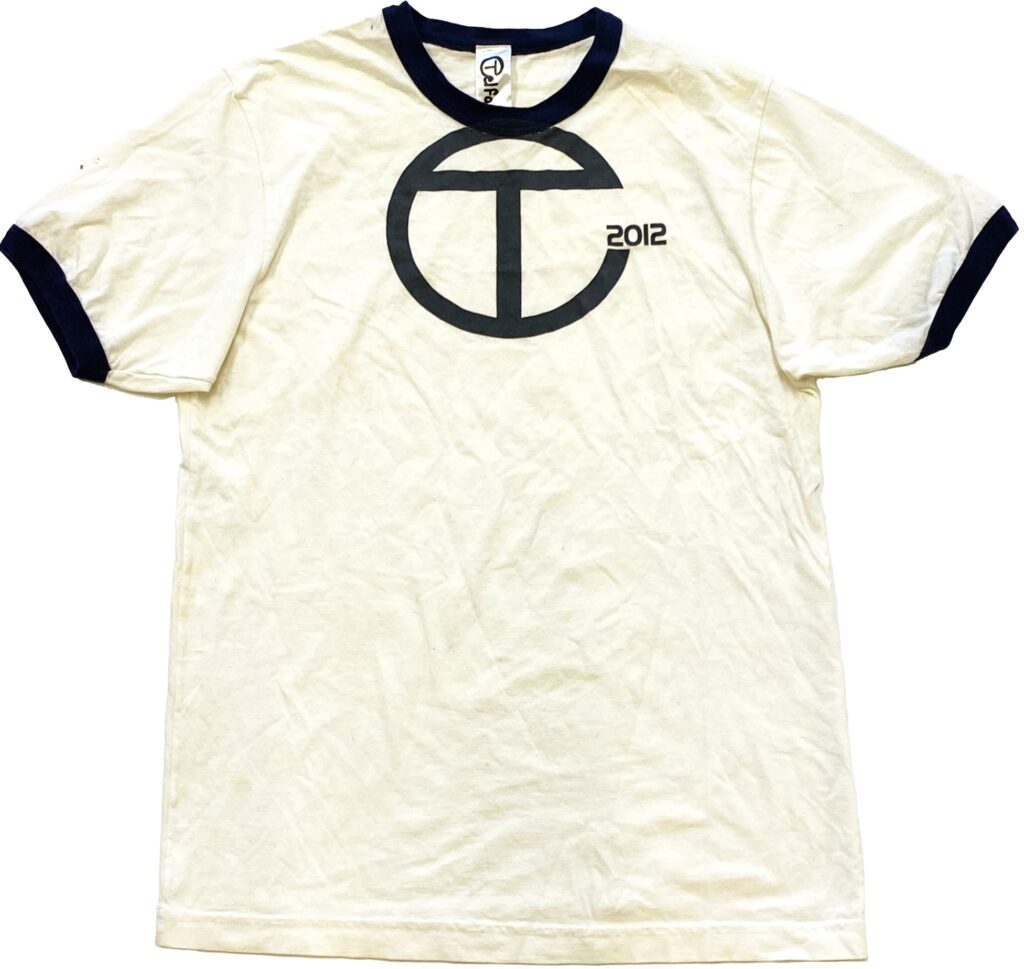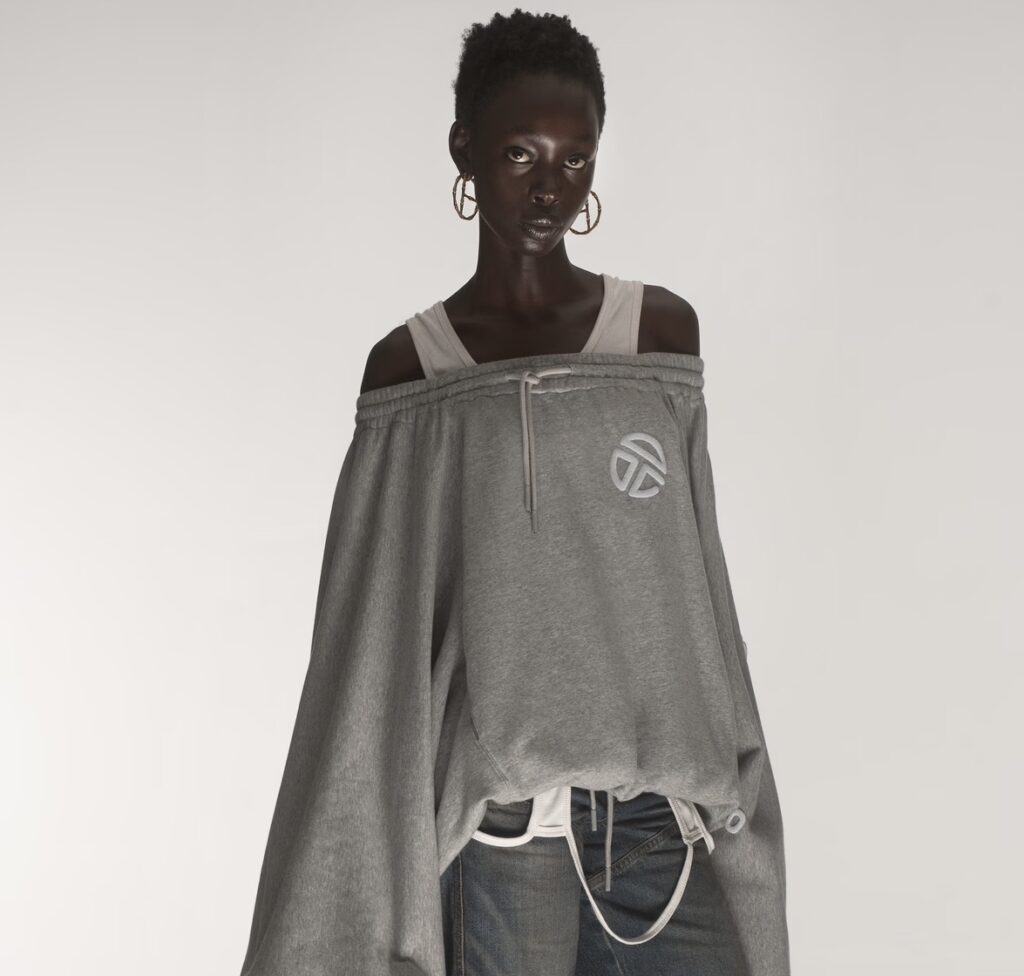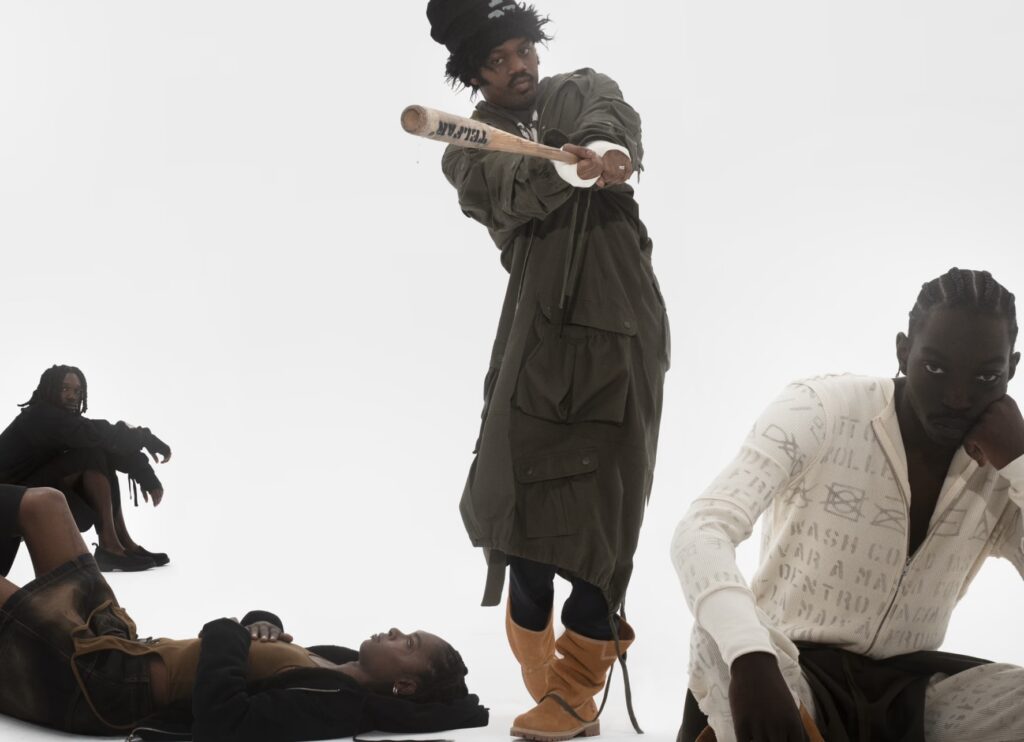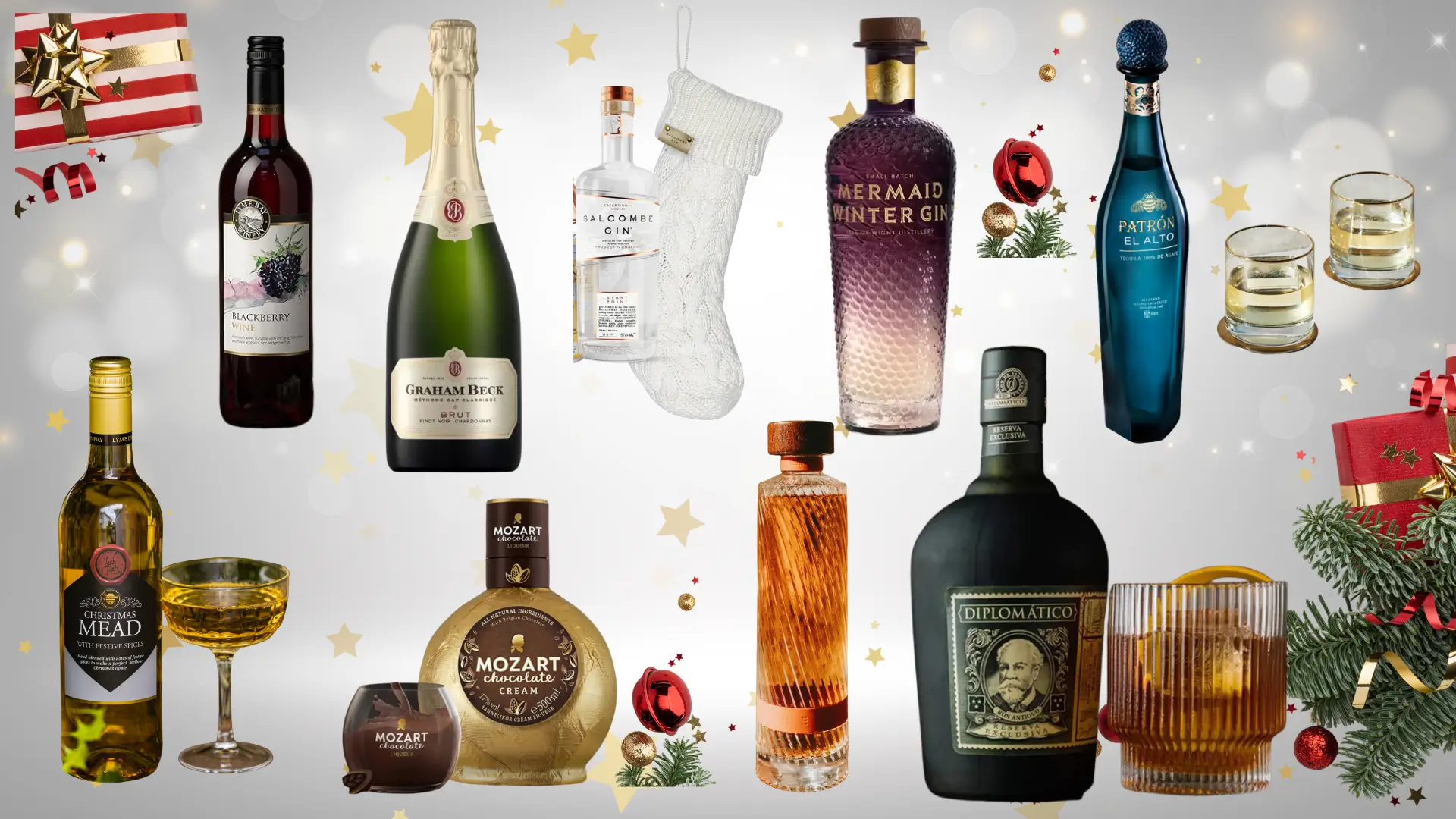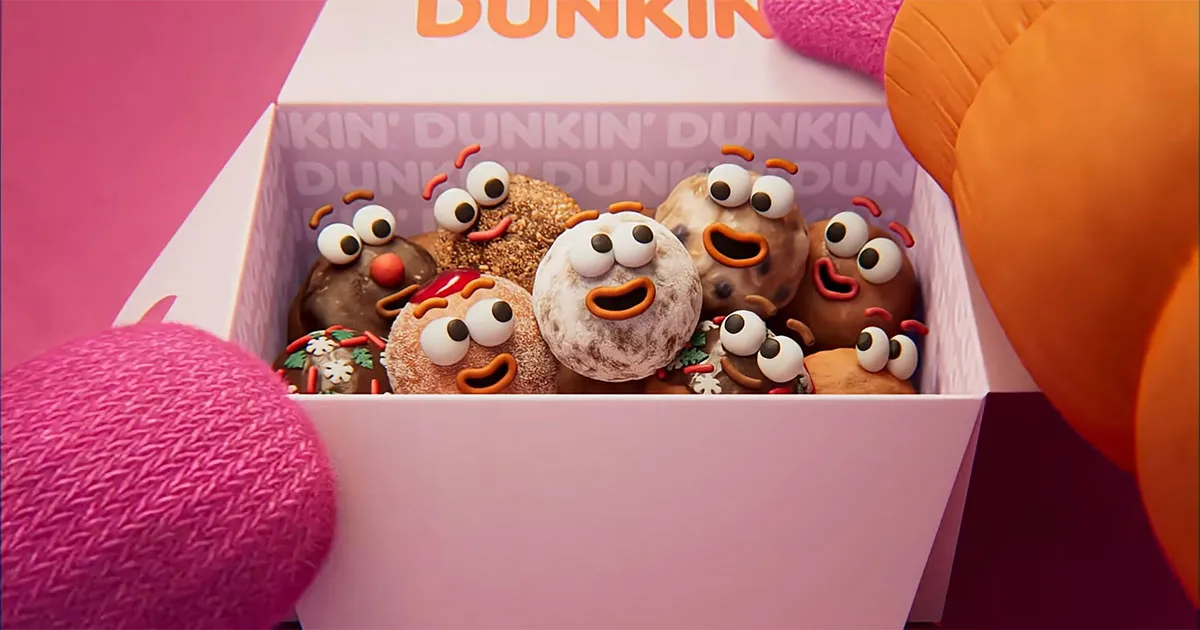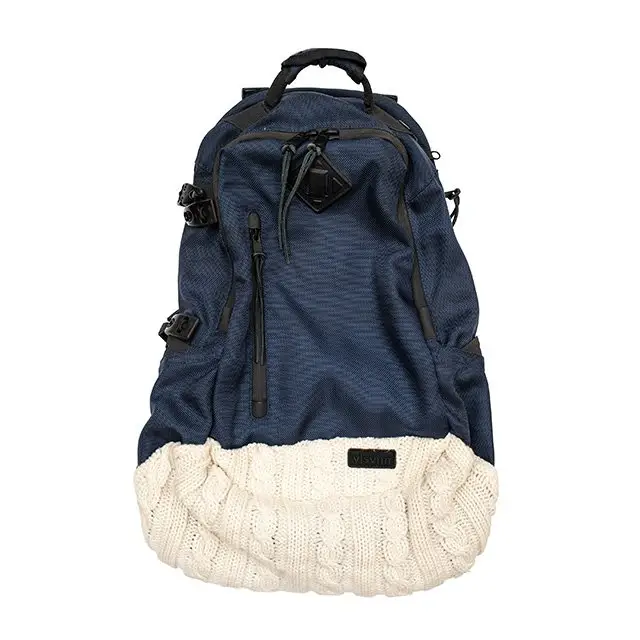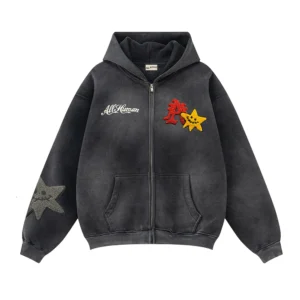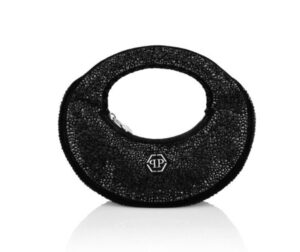Telfar Clemens has long resisted the gravitational pull of luxury fashion’s elitism. Since founding his label in 2005, Clemens has dismantled hierarchies, democratized access, and blurred the lines between streetwear and high fashion. His mantra—“Not for you, for everyone”—is not a marketing slogan, but a philosophy encoded into every stitch, campaign, and casting choice.
As we step into Fall 2025, Telfar’s direction crystallizes into what might best be described as the radical everyday: garments that reimagine familiar forms, reinterpret the communal wardrobe, and redistribute power in fashion imagery itself. The images enclosed here—whether a ringer tee recalling the brand’s earlier experiments, an off-shoulder hoodie morphing into sculpture, or a staged ensemble where models embody narrative tension—capture the breadth of this ethos.
This editorial examines the circumference of Telfar Clemens’ fashion direction: its history, its cultural interventions, and its 2025 crystallization of flow, variance, and inclusivity.
Telfar Before the Mainstream
Telfar Clemens, a Liberian-American designer raised in Queens, New York, entered the scene in 2005 when fashion was still rigidly gendered and dominated by Eurocentric standards. His earliest collections were dismissed by critics for being too “street,” too “unpolished”—yet these same qualities seeded the revolution that would come later.
The 2010s marked a turning point. The launch of the Telfar Shopping Bag (dubbed the “Bushwick Birkin”) transformed the brand into a cultural force. Unlike luxury bags that thrive on scarcity, Telfar made ubiquity its currency. The bag wasn’t merely an accessory; it was a social equalizer, an item as likely to be carried in a corner store as in a Vogue editorial.
By the time Clemens won the CFDA/Vogue Fashion Fund in 2017, the industry was finally forced to reckon with a designer who had been years ahead of the curve. Inclusivity, gender fluidity, and accessibility—once seen as niche—were becoming central to global fashion discourse.
Flow as Fashion Philosophy
The word flow best describes Telfar’s design logic. Flow between genders, between categories of dress, between haute and bespoke streetwear.
In Fall 2025, flow is literalized through silhouette. Take the oversized grey hoodie (Image 2): a garment normally coded as casual is slouched off the shoulders, cinched at the neckline, and ballooned into sculpture. It floats between sweatshirt and eveningwear, between sportswear and high-art installation.
The collection’s styling further amplifies this sense of flow. Models are cast not as anonymous clothes hangers, but as living extensions of Clemens’ cultural universe.
Variance and the Fashion Spectrum
Telfar’s variance lies in its ability to speak across registers of fashion culture. The cream ringer T-shirt with the 2012 logo (Image 3) recalls DIY merch aesthetics, a nod to underground economies of style. It is casual, direct, wearable by anyone, anywhere.
Meanwhile, the editorial tableau with multiple models (Image 1) demonstrates variance on a different plane. The man wielding a Telfar-branded baseball bat in military green outerwear embodies aggression and defense; beside him, another model lounges in logo-printed knitwear, his expression contemplative. On the floor, a reclining figure evokes softness and vulnerability. Together, they stage a multiplicity of roles, emotions, and narratives within a single frame. Variance here is not only about clothing silhouettes, but about the full emotional and cultural bandwidth fashion can occupy.
Telfar’s collections refuse to settle into one archetype of beauty or luxury. Variance is the strategy: a constant oscillation between utility and excess, softness and strength, everydayness and theatricality.
The Motifs of Fall 2025
Several motifs dominate the Fall 2025 collection:
-
Reconstruction of Casualwear
Sweatshirts, hoodies, and workwear jackets are dismantled and reconstructed. The oversized grey hoodie becomes off-shoulder couture; cargo pockets swell across coats until they resemble sculptural pouches. -
Narrative Editorial Staging
Unlike runway uniformity, the Fall 2025 imagery emphasizes narrative dissonance. The baseball bat is a prop, but also a metaphor: defense against appropriation, assertion of space. Fashion becomes theater. -
The Legacy of the Logo
From the 2012 ringer tee to subtle embroidery on sculptural hoodies, the Telfar logo functions as both brand marker and cultural emblem. Its circulation is no longer about branding alone—it signifies belonging to a movement. -
Utility Meets Ornament
Drawstrings, pockets, and toggles dominate, but they are exaggerated into ornaments. Function bleeds into decoration, refusing fashion’s binary of “practical vs. pretty.”
Telfar in Fashion Culture: 2025 and Beyond
By Fall 2025, Telfar has become a lodestar for global fashion culture. While luxury houses chase youth relevance through celebrity campaigns, Clemens remains rooted in community. The models here aren’t merely placeholders; they embody a broader Black futurist aesthetic, where resilience, creativity, and communal flow shape the horizon.
The presence of props, asymmetry, and layering in the Fall 2025 imagery reflects a culture weary of polished perfection. Instead, Telfar embraces mess, variance, and contradiction—mirroring the realities of contemporary life.
Fashion culture in 2025 is fractured: on one end, hyper-exclusive couture; on the other, fast-fashion ubiquity. Telfar refuses both poles, occupying the middle ground where luxury is democratized, not diluted. It is here, in this messy middle, that the future of fashion seems most alive.
The Model as Message
In all three images, models are central to decoding the collection’s meaning. The casting is precise: Black bodies, queer gestures, defiant stares. Their presence itself is a critique of fashion’s historic exclusions.
-
The model in grey hoodie (Image 2) embodies fluidity—garment flowing off the shoulders, gaze unflinching.
-
The group tableau (Image 1) creates a communal choreography, suggesting solidarity even amid variance of stance.
-
The ringer tee (Image 3), flat-laid, reminds us of the wearer not shown: a ghostly body absent yet implied, democratizing the garment’s reach.
Models in Telfar are not just wearers of clothes; they are co-authors of meaning.
From Subculture to Mainstream Institution
What makes Fall 2025 distinct is how it consolidates Telfar’s journey. No longer dismissed as “niche” or celebrated only for the Shopping Bag, Clemens demonstrates full mastery of form and image. The collection balances sculptural experimentation with accessibility, ensuring the radical everyday remains wearable.
Telfar’s direction now sits at the intersection of fashion house and cultural institution. The brand functions less like a seasonal label and more like a platform—a place where marginalized communities find affirmation and visibility.
Fall 2025 signals that Telfar is not content with past victories. Instead, Clemens continues to destabilize: turning hoodies into gowns, workwear into editorial sculpture, and logos into cultural codes.
Impression
To explicate Telfar Clemens’ fashion direction is to map a circumference rather than a straight line. The brand expands in multiple directions at once: past and future, street and couture, community and commerce. Fall 2025 crystallizes this circumference into a coherent yet varied whole.
The enclosed images capture these arcs: the archival echo of the 2012 tee, the sculptural hoodie of 2025, and the communal tableau that stages fashion as living theater. Together, they reveal a designer at the peak of his powers, yet still restless, still radical, still insisting fashion be not for you—but for everyone.
No comments yet.

